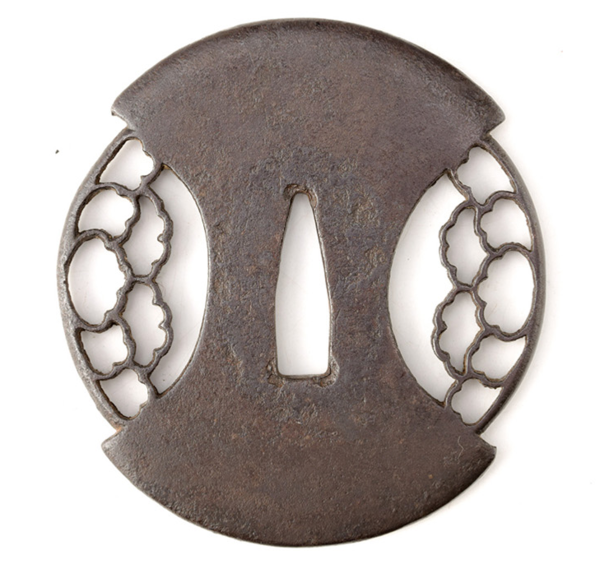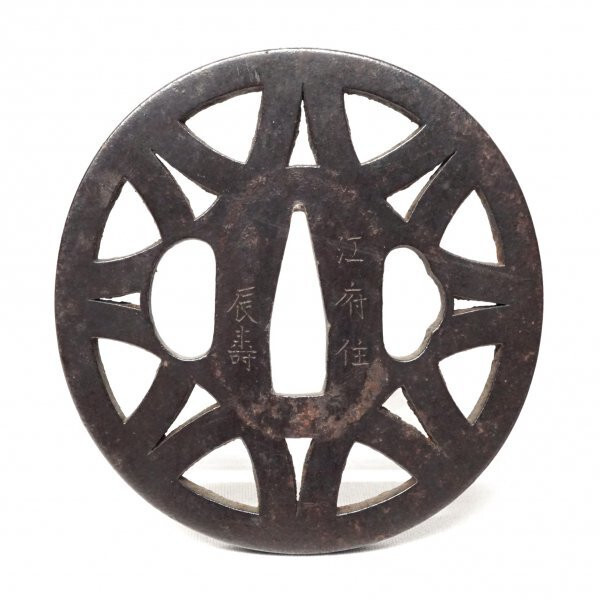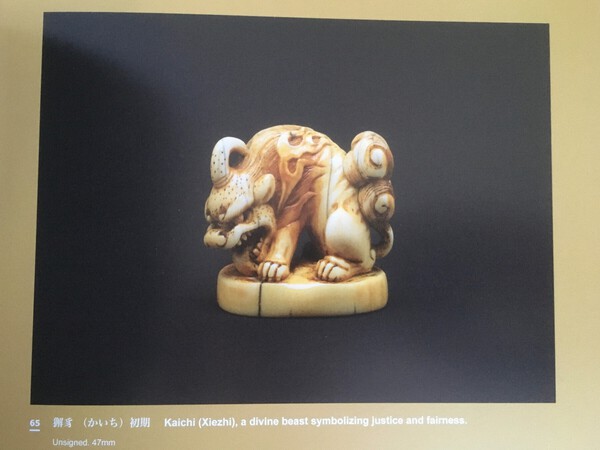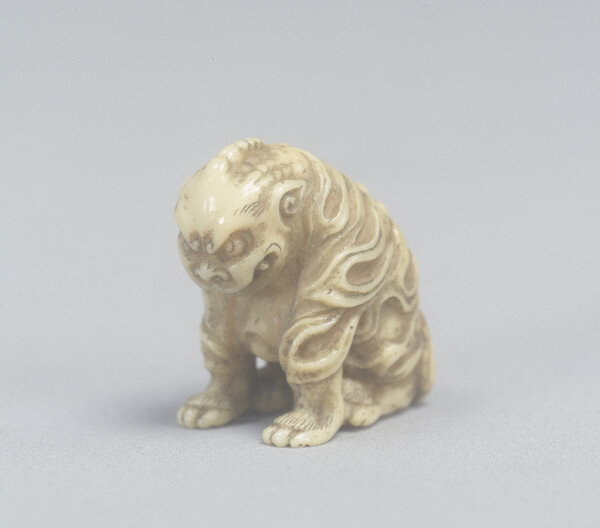-
Posts
738 -
Joined
-
Last visited
-
Days Won
2
Content Type
Profiles
Forums
Events
Store
Downloads
Gallery
Everything posted by PietroParis
-
One more from Yahoo! Japan. The seppa dai is heavily corroded, but the Hozon certificate attributes it to Tatsutoshi:
-
-

A series of fittings ( or how not to build a collection )
PietroParis replied to Bob M.'s topic in Tosogu
Last one and then I swear I’ll stop: this is identified as a Kaichi by a well known Japanese scholar/dealer of netsuke: -

A series of fittings ( or how not to build a collection )
PietroParis replied to Bob M.'s topic in Tosogu
For those who remember the sprawling discussion a few months ago on the Japanese representations of the mythical beast 白澤 BaiZe/Hakutaku, I would like to share two more examples of the "flaming horned lion" version that I stumbled onto later. I tried to add them directly to my old summary (see this link) but I can no longer edit it. The first is again by Tachibana Morikuni, in an encyclopedia of Chinese things named "Morokoshi kinmo zui" (see this link): The second is a netsuke in the Go collection at Tokyo National Museum (see this link). This one attests that the shishi-like representation, alternative to the extra-eyed, cow/goat-like representation, is still recognized by Japanese curators as Baize/Hakutaku: Cheers, Pietro -
Just in case anyone didn't know: https://archive.org/details/japaneseswordmou00joly/mode/2up
-

Gendaito by Kawashima Tadayoshi in shingunto koshirae
PietroParis replied to Ray Singer's topic in For Sale or Trade
I presume shinshinto -> shingunto in the title. -
Another tsuba on eBay whose style looks familiar even if the signature 宜壽 Yoshitoshi is not in Markus Sesko's lineage for the Akao & Ito school:
-

Help to identify these swords Tokyo national museum
PietroParis replied to Paz's topic in General Nihonto Related Discussion
You could try to match them with these pictures from the museum's website: https://colbase.nich.go.jp/organizations/1/collection_items?locale=en&limit=100&organization_id=1&with_image_file=1&only_parent=0&free_word=katana https://colbase.nich.go.jp/organizations/1/collection_items?locale=en&limit=100&organization_id=1&with_image_file=1&only_parent=0&free_word=tachi https://colbase.nich.go.jp/organizations/1/collection_items?locale=en&limit=100&organization_id=1&with_image_file=1&only_parent=0&free_word=wakizashi -
I have this cross(?) shaped, unsigned tsuba, papered Shoami: It was discussed earlier in this thread.
-

Murphy is a dirty bastard!!
PietroParis replied to Bigsgtg's topic in Auctions and Online Sales or Sellers
-

A series of fittings ( or how not to build a collection )
PietroParis replied to Bob M.'s topic in Tosogu
-

A series of fittings ( or how not to build a collection )
PietroParis replied to Bob M.'s topic in Tosogu
Like the weirdly asymmetric hitsu ana? [EDIT: no, that's like the original - sorry] [2nd EDIT: a Tadamasa reproduction was discussed long ago in the forum, but the picture alas has disappeared] -
Indeed, he is not in Markus Sesko's genealogy but the theme and the "toshi" suggest some relation.
-
I'd guess stuff he found while poking around with a metal detector?
-
-

Mythical animal from a pictures book
PietroParis replied to PietroParis's topic in Translation Assistance
Hi Thomas, all of these pictures are discussed at length in the last two pages of this other thread: https://www.militaria.co.za/nmb/topic/34920-a-series-of-fittings-or-how-not-to-build-a-collection/ see in particular this summary: https://www.militaria.co.za/nmb/topic/34920-a-series-of-fittings-or-how-not-to-build-a-collection/page/20/#comment-398868 The picture that you posted is not a Kirin, unless you use the term in the very wide sense of "mythical horned creature". In particular, Kirin are supposed to have hooves. Based on what transpired from the discussion in the other thread, it appears that yours is rather a 獬豸 (Xiezhi/ Kaichi). -

A series of fittings ( or how not to build a collection )
PietroParis replied to Bob M.'s topic in Tosogu
P.S. Do what you want with this additional piece of information: going back to the early posts of this discussion, I noticed that for Joly Kaichi is another name of the Hakutaku. Clearly he was sticking to the tradition of the Hakutaku as a flaming horned lion, which I would not consider "wrong" but just alternative to (and co-existing with) the cow-like, multi-eyed tradition. -

A series of fittings ( or how not to build a collection )
PietroParis replied to Bob M.'s topic in Tosogu
I was trying to get to the bottom of the matter while following only the historical sources available. I'm glad that the subject of the tsuba is identified beyond doubt now, I feel less bad about hogging all these pages. As I am also a netsuke collector, I was mainly interested in the Hakutaku business. Thanks to Piers' input, I have now added a point 3bis to the writeup above concerning another possible occurrence of the flaming-horned-lion version in Japanese literature. I am constantly reminded of the fact that being unable to read Japanese is a big handicap in this endeavor, which makes the results inevitably amateurish... -

Mythical animal from a pictures book
PietroParis replied to PietroParis's topic in Translation Assistance
Thanks Piers! that's very valuable for the Hakutaku discussion in the other thread, as it reinforces the idea that even in the Japanese literature there are two "parallel" versions of the beast (a lion-like one with just two eyes and a cow-like one with extra eyes on the sides). -

Mythical animal from a pictures book
PietroParis replied to PietroParis's topic in Translation Assistance
Sorry if I drag this on, I am just curious to tie a loose end. Could anybody please read for me the name of this other beast? Again, it should be the two boldface characters on the top right corner. -

A series of fittings ( or how not to build a collection )
PietroParis replied to Bob M.'s topic in Tosogu
And will you admit that it is absurd to claim that early 17th-century depictions of an imaginary animal are "mistaken"? And most importantly, why do you have to turn this into a pissing contest? After finding the picture that the maker of the tsuba was inspired by – which does not seem related to the legend in the "Yunji Qiqian", although I cannot read the text – it is clear that the animal on Bob's tsuba is not a Hakutaku. So? -

Mythical animal from a pictures book
PietroParis replied to PietroParis's topic in Translation Assistance
Solved in the other thread: they read 獬豸Kaichi. Of course if anybody is able to translate the rest of the text please go ahead! -

A series of fittings ( or how not to build a collection )
PietroParis replied to Bob M.'s topic in Tosogu
Well then, problem solved! The Wiki page of the Xiezhi does not mention a Komainu connection, and this page lists the Kaichi among "Imaginary beasts other than Komainu". However, a google search for "kaichi komainu" does yield pages that suggest such connection (e.g., "seen as a Chinese equivalent of the Japanese komainu" ). For me the moral of the story is that the only way to figure out which among dozens of similar beasts (in this case, horned lion-like creatures) in Chinese/Japanese mythology is represented in a given artifact is to find the image that the artisan was inspired by. More often than not it is going to be from some collection of sketches such as the one by Morikuni. P.S. the Wiki page linked above also offers another view of the statue found by Bob: -
Hi All, A longish discussion has developed in the Tosogu section on the identification of a beast depicted on a Choshu tsuba. I have eventually found an illustration from a book entitled 絵本写宝袋 (Ehon shaho bukuro / Picture Book: Treasure-bag of Sketches) published in 1720 by one Tachibana Morikuni 橘守国, see this link. The animal on the right is clearly our guy. Can anyone please translate the name, which is probably given by the two boldface characters on the top-right corner of the picture?
-

A series of fittings ( or how not to build a collection )
PietroParis replied to Bob M.'s topic in Tosogu
I'm posting a request in the Translation section.



















